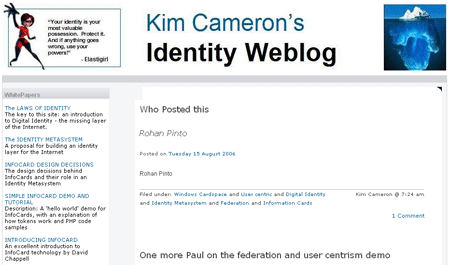The ever-interesting James McGovern posted about Encryption Based Encryption a while ago, wondering if Microsoft and Sun might add it to their product suites.
I was so busy travelling that I got swept away by other issues, but Sun's Pat Patterson persisted and recently posted a cogent note by Radia Perlman, one of his colleagues, which I thought hit a lot of the issues:
Identity based encryption.
Sigh.This is something that some people in the research community have gotten all excited about, and I really think there's nothing there. It might be cute math, and even a cute concept. The hype is that it makes “all the problems of PKI go away”.
The basic idea is that you can use your name as your public key. The private key is derived from the public key based on a domain secret, known to a special node called the PKG (private key generator), which is like a KDC, or an NT domain controller.
Some of the problems I see with it:
a) public key stuff is so nice because nobody needs to know your secret, and the trusted party (the CA) need not be online. The PKG obviously needs to be online, and knows everyone's secrets
b) If Alice is in a different trust domain than Bob, she has to somehow securely find out Bob's PKG's public parameters (which enable her to turn Bob's name into a public key IN THAT DOMAIN).
c) Bob has to somehow authenticate to the PKG to get his own private key
d) There is no good answer to revocation, in case someone steals Bob's private key
e) There is no good answer to revocation, in case someone steals the PKG's domain secret.
I've seen hype slides about identity based encryption saying “which identity is easier to remember?
In PKI: 237490798271278094178034612638947182748901728394078971890468193707
In IBE: radia.perlman@sun.comThis is such ill-conceived hype. In PKI no human needs to see an RSA key. The RSA key is not your identity. Your identity is still something like radia.perlman@sun.com
So, it looks like IBE gives with one hand (sender can create a public key without the recipient's involvement) but takes much more away with the other (key secrecy, PKG has to be online, revocation issues). I guess there is no such thing as a free lunch…
Let me put the same points just a bit differently.
IBE is very interesting if you think everyone in the world can trust a single authority to hold everyone's secrets.
OK, now let's move on.
When you do have multiple authorities, you need a way to discover those, so you need a secure email-to-authority mapping and lookup. Yikes. The only way to do that which is simpler than public key itself, is to use mail domains as the authority boundary combined with some kind of secure DNS.
But in that case, your mail server can decrypt anything you receive, so it's no better than a conventional edge to edge encryption scheme (e.g. where mail from me to Pat gets encrypted leaving the Microsoft mail system and then decrypted when entering the Sun mail system).
Edge encryption is pretty well what everyone's building anyway, isn't it? So what's the role for PBE?
My vision is that one day, Information Cards will be used to convey the information needed to do real end-to-end encryption using asymmetric keys – without the current difficulties of key distribution. This said, signing interests me a lot more than end-to-end encryption in the short term.
More about this some other day.

 He was able to use a vulnerability in WordPress to employ his “subscriber” account (which normally only grants comment rights) in order to import a fake post onto my site (I've since removed it but it is shown at the right).
He was able to use a vulnerability in WordPress to employ his “subscriber” account (which normally only grants comment rights) in order to import a fake post onto my site (I've since removed it but it is shown at the right).